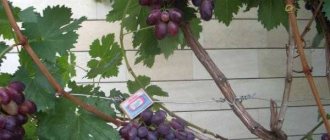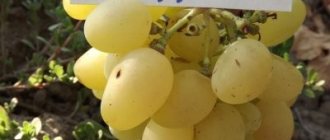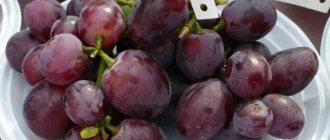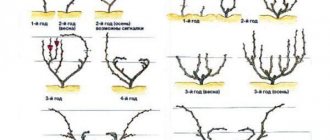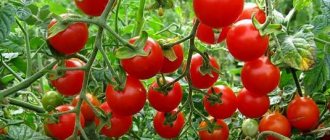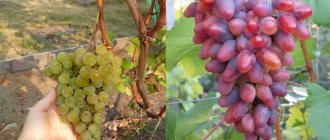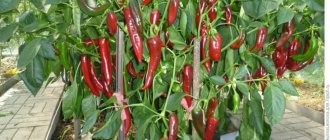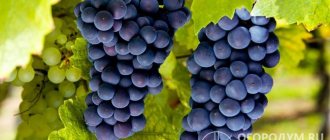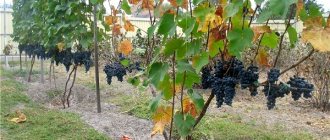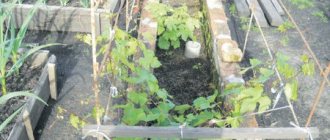Origin
As a result of crossing “Kishmish radiata” and “Talisman”, a new grape variety “ruta” was obtained, which absorbed all the positive characteristics of its “parents”: beautiful color of berries, frost resistance and good preservation during transportation. The author of such an experiment was the Ukrainian amateur breeder Zagorulko V.V.
Parents of “ruta” – “kishmish radiata” – and “talisman”
Main characteristics
“Rue” is an extra-early table variety with fairly large berries and a classic taste.
Ripening period
The growing season of the variety lasts 95 - 100 days, the beginning of harvesting occurs in early - mid-August. This allows us to consider “ruta” grapes as a variety with an extremely early ripening period. Ultra-early ones also include “crystal”, “lorano” and “transfiguration”.
Bush
The “ruta” variety is a vigorous plant that requires mandatory formation of the bush and rationing of the yield. The leaves are quite large, wide, five-lobed. But the flowers of the variety are only female, so before planting it is necessary to think about placing another grape next to it that can pollinate the “rue”.
Sparvka! The Arcadia grape is considered ideal for pollinating rue.
Bunches and berries
The brushes are of medium size and medium degree of looseness, their average weight usually reaches 500 – 800 grams. The shape of the bunches is conical.
Rue berries are relatively large - about 12 g each. Their shape resembles an oval or ellipse. Attention is drawn to their bright color: pink, but sometimes shades of crimson and amber yellow are added to this tone.
The top of the berries are covered with a thin and delicate skin, which is absolutely not noticeable when eating grapes. The pulp is juicy and dense. The seeds are quite large, but they do not cause discomfort when eating the berries.
The sugar content is also encouraging - 20 - 21% with an acidity of 7.5 g/l.
Taste and yield
The berries have a bright grape taste with a slight nutmeg sweetness.
“Rue” demonstrates good yield indicators - up to 18 kg per bush.
Description
Berries weighing 7-12 grams. Their shape is stated as nipple-shaped, but in photographs they are also oval, only slightly elongated. The taste is ordinary, varietal, grape, harmonious. Some people find light nutmeg tones in it. Sugar accumulation is high, up to 20%.
The meaning of the name Lisa and Erast. The name Erast in different languages. The name Erast as a phrase
The color is mostly pink, sometimes with a raspberry tint, and sometimes with an amber-yellow tint. The seeds are tangible. The berries color well in bright sun, which not all pink-berry hybrids can boast of.
The clusters are large, but not excessively, weighing 500-800 grams. Their shape is conical, looseness is medium. Ruta ripens very early, in less than 100 days from the moment the buds open. This happens around August 1 - at least in the Zaporozhye region, where the variety was bred. The berries hang well on the bushes, without falling off and retaining their taste until November.
The growth vigor of the described hybrid form is outstanding. This can become an inconvenience if the plantings are dense or the supports are not strong enough. But Ruta gives few stepchildren, so it becomes easier to carry out green operations. There is no need to standardize the variety. And the vines ripen almost completely. The leaves are large, with five lobes.
The variety has a functionally female flower type (FFT). For example, the widespread Arcadia is good as a pollinator. Many similar hybrids do not have any difficulties with pollination. But in Ruta, this feature is combined with particularly rapid vegetative growth, so due to the abundance of vines and leaves, the brushes are not always pollinated well.
Comparison with analogues
The “ruta” variety, despite the short history of its existence, has managed to establish itself as one of the best very early and very early ripening grapes.
| Sign | Variety | |||
| Ruta | Libya | Kostrikin's anniversary | Veles | |
| Ripening period | 95 – 100 days | 105 – 110 days | 100 – 115 days | 95 – 105 days |
| Frost resistance | -21C | -21C | -24С | -21C |
| Productivity | Up to 18 kg | 15 – 20 kg | Up to 15 kg | 10 – 15 kg |
| Bunches | 400 – 800 g | Up to 1 kg | 400 – 500 g | 1.8 – 2 kg |
| Taste | Fruity with nutmeg flavor and aroma | Taste of nutmeg | Taste of honey | Muscat notes |
| Color | Pink with crimson and yellow tints | Light pink | Dark pink | Pink |
| Disease resistance | Above average | Below average | Above average | Above average |
| Shelf life | 1 month | 1 month | 1 – 2 months | Up to 3 months |
| Sugar accumulation | 20% | 20% | 18 – 20% | 17 – 22% |
| Acidity | 7.5 g/l | 6 – 7 g/l | 6 – 7 g/l | 5 – 7 g/l |
“Ruta” next to “Veles”
Useful properties and applications
“Rue”, like red and pink grape varieties, has a number of beneficial properties for the health and well-being of women, men and children:
| For women | For men | For children |
| Is an excellent prevention of premature aging | Supports normal sexual function | Strengthens the immune system and increases appetite |
| Improves psycho-emotional state, including during PMS | Helps cure infertility | Participates in the formation of bone tissue |
| Normalizes hormonal levels | Improves the quality of seminal fluid | Activates brain activity |
| Prevents the development of breast cancer and skin cancer | Accelerates sperm movement | Prevents the development of anemia |
Reference! Pink grapes are quite high in calories: 100 g of berries contain 69 kcal.
“Rue” is a universal table variety; its fruits are good fresh, as well as an ingredient in culinary dishes and canning. You can also make wine and juice from these grapes.
Before you choose
If a gardener decides to plant grapes, he needs to carefully select the optimal variety of fruit. To make the perfect choice, you need to follow several recommendations:
- firstly, you should clearly know whether a given species produces an annual harvest, plus what level of its yield; There is also a pressing question about the quality of berries;
- secondly, the choice of fruit depends on the characteristics of the planting area; if it grows in conditions of high humidity, the variety must be resistant to cracking;
- thirdly, the fruit must withstand possible frosts or diseases.
Consequently, the more the variety meets this description, the greater the likelihood that the winegrower will receive a good harvest, and caring for the vines will bring only pleasure.
Features of cultivation
If you follow the rules of planting and care, rue grapes will delight you with an excellent harvest for a long time.
Boarding time
The preferred time for planting the “ruta” variety is spring, precisely during the period when the plant has not yet opened its buds. Experienced winegrowers recommend: if the seedling was purchased in the fall, then it is better to dig it in until spring.
Place and soil
Ruta grapes are not picky about soil composition, but they produce the best harvest on black soil. The place where it grows should be well lit and protected from winds and drafts. A good option is next to the southern wall of a house or any other structure, which will become a kind of protective shield. The distance to the nearest plants should be at least 3 meters, otherwise the rapidly growing vines will begin to shade the lower bushes.
Important! The recommended dimensions of the planting hole are 0.8 x 0.8 x 0.8 m. The distance between neighboring bushes is 2.5 - 3 meters, between rows - 3 meters.
Watering and fertilizing
After planting the seedling, it must be watered and the soil mulched with peat, humus or sawdust. Next, watering is carried out according to a strictly established scheme:
- when tying;
- a week after pruning;
- a week before flowering;
- during the formation of brushes;
- a month before the start of harvest;
- before wintering.
Vineyard drip irrigation hub
Reference! The recommended volume of water for irrigation is 20 liters per bush.
Another important condition for a good harvest is the application of fertilizers. This must be done three times per season:
- The first is in early spring (nitrogen).
- The second - 2 weeks before flowering (bird droppings with phosphorus).
- The third - after the appearance of the ovary (potassium with superphosphate).
Trimming
The grapes need pruning. After winter, be sure to carefully inspect the bush and remove all diseased, dried out or growing shoots in the wrong direction. During the formation of the first ovary, it is necessary to remove the stepsons and weak bunches.
The formation of the bush is carried out in the fall after the leaves fall. Each shoot is pruned into 8–10 buds based on the optimal load on the bush of 55–60 buds.
Diseases and pests
“Rue” has high resistance to fungal diseases, but at least two treatments for preventive purposes still need to be carried out. Fungicides, which can be purchased at any specialty store, are ideal for these purposes.
This is what grape itch looks like
Among the pests, the most dangerous are the leaf roller, grape mite, and phylloxera. Purchased insecticides will come to the rescue:
- Against the leaf roller: Tsidial, Tsimbush, Fozalon, Sevin, Bi – 58.
- From grape mite: Neoron, Aktellik, Talstar, Omoit.
- Carbon disulfide to combat phylloxera.
Wintering
The variety can survive without shelter in winter only in the southern regions: Crimea, Krasnodar Territory, southern Ukraine, Moldova, the Caucasus. At all points located north of those listed, shelter is required, although sources indicate that the variety can safely withstand frost of -21ºC.
Typically, spruce branches, spunbond, roofing material, and agrofibre are used as cover. In the absence of all of the above, you can sprinkle the vines bent to the ground with earth.
The variety can be cultivated in almost all regions of the Russian Federation, but the best yields are in the southern regions.
Harvest storage
The variety is able to retain its taste and commercial characteristics for one month, subject to the required temperature conditions (0ºС – +5ºС).
History of selection of the Ruta variety
The Ruta variety was bred by breeder Vitaly Zagorulko in the Zaporozhye region of Ukraine. The parents of this grape were the varieties Talisman and Kishmish radiant.
Ruta grapes acquired their high winter hardiness and tendency to overgrow from the Talisman variety.
From Talisman, the Ruta variety also received high transportability of berries and their long shelf life
But the color and shape of the berries came from the Rute grape variety Kishmish radiant.
The Kishmish Radiant variety also gave the Ruta grape its sugar content and acidity
For a long time, Ruta grapes were not widely known in Russia, but since 2015, more and more gardeners are planting this variety on their plots.
Description of Ruta grapes
The Ruta grape variety is a very vigorous plant, with a small number of side vines - stepsons. In connection with this, the plant does not need to be rationed. The leaves of the grape are large and wide, having five lobes.
The plant has fast and abundantly growing vines that are almost completely ripe
The flowers of this variety are female, so it is better to plant Arcadia grapes nearby, which will perfectly pollinate Ruta flowers. You should also be prepared for the fact that the excessively rapid growth of Rue’s shoots will interfere with the pollination of its flowers.
The berries themselves are large, shaped like an oval or ellipse. Collected in large and medium-loose clusters, the berries have a bright grape taste with a slight nutmeg sweetness.
The berries have a beautiful transition from a delicate yellow color to a bluish-raspberry hue
The berries have medium-sized seeds and tend not to fall off the bush for a long time.
Characteristics of the Ruta variety
It should be noted that the ripening dates are indicated for the region where the variety was bred, and for other regions the dates may shift slightly.
Proper planting of Ruta grapes
In order for the Ruta grape bush to grow healthy and bear fruit abundantly, you need to choose the right planting site.
- The place should be illuminated by the sun for about 10 hours a day.
- The landing site should be located on the south side of all nearby buildings.
For grapes of this variety, planting using the trench method is desirable. Therefore, you need to dig a trench 60 cm deep and place strong trellises along the ditch, which you can make yourself from metal pipes and wire. We place two-meter pipes at a distance of 2 meters from each other.
Ruta grapes are also good to clamp onto arched supports, you just need to maintain the correct distances
The grapes themselves should sit according to the following pattern: row spacing - 3 m, distance between bushes should be 2.2 - 2.5 m.
The best time to plant the Ruta variety is spring, before the buds fully open. If the seedlings were purchased in the fall, you need to carefully dig them in before the spring season.
Immediately before planting, prepare the following fertilizer mixture:
Approximately 1 bucket of the prepared fertilizer mixture is laid out for each meter of trench dug. Then the soil must be thoroughly loosened. The next step is to place a seedling of the Ruta variety in the center of the trench, strictly following the planting pattern.
Carefully straighten the root system of the plant
At the end of planting, the seedling should be sprinkled with soil. He crushes the soil around the grape bush with his hands, compacting it. Then we water and mulch (you can use sawdust) in order to maintain the moisture of the soil substrate.
5 golden rules for caring for the Ruta variety
In order for the Ruta variety to produce a large harvest, you need to follow 6 simple rules of care.
- Trenches with grapes of this variety must be watered at certain strict intervals.
For example, the soil in the area where the Ruta variety is planted dries out once a week, then watering is carried out once a week so that the soil is always moist, but not wet. To make caring for grapes easier, you can extend drip irrigation along the trench - Ruta grapes require regular loosening.
The exhausting procedure of loosening can be carried out less often if you mulch the soil with sawdust or bark - At the “pea” stage, we form young grape plants using pruning, focusing mainly on the volume of fruit set.
This procedure will eliminate the disadvantage of overgrowth. The main task of formation at the “pea” stage is to give young grapes the opportunity to spend most of their energy on fruit growth - We prune old bushes, leaving about 55–60 buds, so the grapevine is not in danger of fattening.
Anti-aging pruning should be done in the spring, before the buds open. - Twice a season we carry out preventive treatment of Rue bushes against diseases.
In the spring, after the snow has melted, the grapes must be treated for diseases and pests.
Reviews
Ruta has enormous growth power and weak stepson formation. Good disease resistance. The taste is unremarkable, but good. Vladimir, Krasnodar
Very beautiful dark pink berry color. A very early variety. Regular grape taste. Svetlana, Novocherkassk
Not resistant to disease, poorly pollinated and grows very strongly. There are better hybrids, I think. Irina Ivanovna, Krasnodar region
